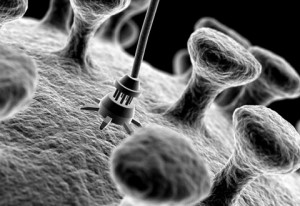An organic transistor that mimics a brain synapse

For the first time, nanotechnology researchers in France have developed a hybrid nano-particle-organic transistor that can mimic the main functionalities of a synapse.
The NOMFET (Nanoparticle Organic Memory Field-Effect Transistor), as it's known, is an organic device made of a molecule called pentacene (an organic semiconductor) and gold nano-particles. It exhibits the main behavior of a biological spiking synapse and can lead to a new generation of neuro-inspired computers, capable of responding in a manner similar to the nervous system.
As Mil-Tech reports, Dominique Vuillaume, a research director at CNRS (the French National Science Agency) involved with the project said; “Basically, we have demonstrated that electric charges flowing through a mixture of an organic semiconductor and metallic nano-particles can behave the same way as neurotransmitters through a synaptic connection in the brain.”
To grasp how a NOMFET works requires a quick review of how neuron networks operate. In the nervous system, a synapse is the junction between two neurons, enabling the transmission of electric messages from one neuron to another and the adaptation of the message as a function of the nature of the incoming signal (plasticity). For instance, if the synapse receives very closely packed pulses of incoming signals, it will transmit a more intense action potential. Conversely, if the pulses are spaced farther apart, the action potential will be weaker. It is this plasticity that the researchers have succeeding in mimicking with the NOMFET. A transistor can be used as a simple switch -- it can then transmit, or not, a signal -- or instead offer numerous functionalities (amplification, modulation, encoding, etc.).
Science Daily explains that the innovation of the NOMFET resides in the original combination of an organic transistor and gold nanoparticles. "These encapsulated nanoparticles, fixed in the channel of the transistor and coated with pentacene, have a memory effect that allows them to mimic the way a synapse works during the transmission of action potentials between two neurons."
"The output of the NOMFET is thus able to reproduce the deceasing or amplifying behavior typical of a synapse depending on the frequency of spikes," Vuillaume recently told Physics World.
The transistor's performance is comparable to the seven CMOS transistors (at least) that have been needed until now to build an electronic synapse and mimic this plasticity. The devices produced have been optimized to nanometric sizes in order to be able to integrate them on a large scale.
Neuro-inspired computers produced using this technology eclipse silicon computers to perform more complex functions comparable to those of the human brain, such as visual recognition.
The study is published in the 22 January 2010 issue of the journal Advanced Functional Materials, and can be accessed on Scribd.
